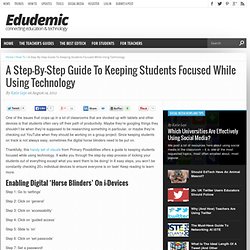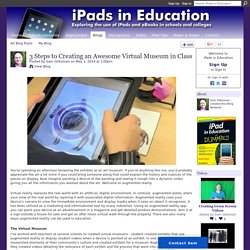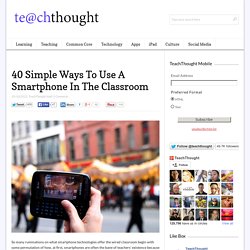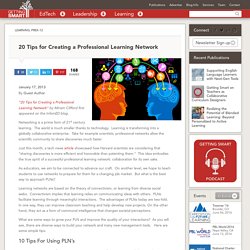

321 Free Tools for Teachers—Free Educational Technology. A Step-By-Step Guide To Keeping Students Focused While Using Technology. One of the issues that crops up in a lot of classrooms that are stocked up with tablets and other devices is that students often vary off their path of productivity.

Maybe they’re googling things they shouldn’t be when they’re supposed to be researching something in particular, or maybe they’re checking out YouTube when they should be working on a group project. Since keeping students on track is not always easy, sometimes the digital horse blinders need to be put on. Thankfully, this handy set of visuals from Primary Possibilities offers a guide to keeping students focused while using technology. It walks you through the step-by-step process of locking your students out of everything except what you want them to be doing! In 8 easy steps, you won’t be constantly checking 20+ individual devices to ensure everyone is on task! Step 1: Go to ‘settings’ Step 2: Click on ‘general’ Step 3: Click on ‘accessability’ Blogs. 3 Steps to Creating an Awesome Virtual Museum in Class. You're spending an afternoon browsing the exhibits at an art museum.

If you're anything like me, you'd probably appreciate the art a lot more if you could bring someone along that could explain the history and nuances of the pieces on display. Now imagine pointing a device at the painting and seeing it morph into a dynamic video giving you all the information you wanted about the art. Welcome to augmented reality. Virtual reality replaces the real world with an artificial, digital environment. In contrast, augmented reality alters your view of the real world by layering it with associated digital information. The Virtual Museum I've worked with teachers at several schools to created virtual museums - student created exhibits that use augmented reality to display student videos when a device is pointed at an exhibit. We used a popular augmented reality app called Aurasma. Visitors were sent an email asking them to download the free Aurasma app and bring their device.
A. B. C. Augmented eTwinning Reality - studio_augusto. On the website The Teacher Garden there is a wide variety of ways to use QR codes in the classroom, such as managing library materials, writing prompts, assessing students, flipping the classroom and making lessons interactive, among many others.

All this activities have been done by teachers of different subjects. In the blog post Interactive Bulletin Boards, third-grade teacher Terri Eichholz explains how she used QR codes in her classroom and engaged students and teachers from other classes in her project. She put her students' artwork on a bulleting board and placed a QR code on each piece. The QR code led the reader to an audio file with students reading their poems. She also put QR codes that led to Google forms where they could vote for their favorite artwork and poem. Using QR code in the classroom by Denise Webster is yet another resource full of examples of best practice and ideas on using QR codes with your students.
Teaching with Aurasma. The magic of QR codes in the classroom - Karen Mensing. eLearning Industry - Post your eLearning article. At eLearning Industry you will find the best collection of eLearning articles, eLearning concepts, eLearning software, and eLearning resources. RSCON5 Text genres links. Pin de Silvia Tolisano em Blogging in Education. Content Curation by Lucian Duma. Tools for flipping classes. 10 Terrific Tools in My Toolkit. Cooltoolsforschools - home. Free Online Course Materials. What is the best way for Continuing Professional Development for teachers? - brainstorming and voting.
40 Simple Ways To Use A Smartphone In The Classroom. So many ruminations on what smartphone technologies offer the wired classroom begin with some permutation of how, at first, smartphones are often the bane of teachers’ existence because they cause disruptions.

This isn’t one of those ruminations. Let’s just go straight to the suggestions, shall we? Use educational apps:One of the simplest strategies for engaging students using smartphones involves taking advantage of the thousands of educational apps as supplements.Create educational apps:After familiarizing kiddos with properly navigating smartphone apps, challenge some of the more tech-oriented ones to design and develop their own; Stanford already offers an open-source class on the subject! Scavenger hunts:Smartphone scavenger hunts have proven a popular pastime for technophiles, and teachers have been known to use them to provide interactive lessons about everything from natural history to nature. 20 Tips for Creating a Professional Learning Network - Getting Smart by Miriam Clifford. “20 Tips for Creating a Professional Learning Network” by Miriam Clifford first appeared on the InfomED blog.

Networking is a prime form of 21st century learning. The world is much smaller thanks to technology. Learning is transforming into a globally collaborative enterprise. Take for example scientists; professional networks allow the scientific community to share discoveries much faster. Just this month, a tech news article showcased how Harvard scientists are considering that “sharing discoveries is more efficient and honorable than patenting them.” As educators, we aim to be connected to advance our craft. Learning networks are based on the theory of connectivism, or learning from diverse social webs.
Internet Catalogue.